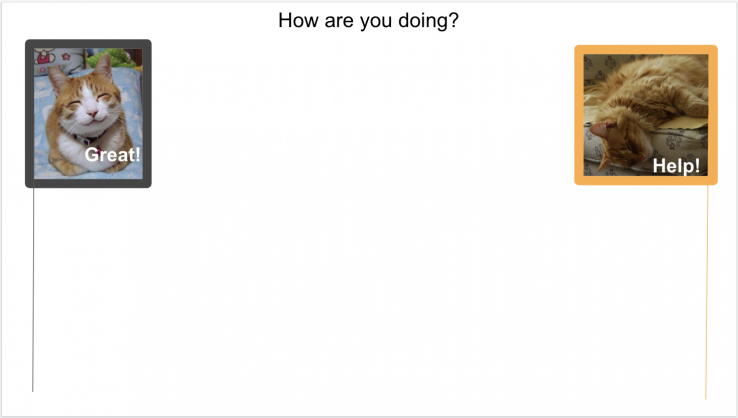“How are you doing, Wolfpack?!” Project
Students’ mental health and wellness are connected to their learning and achievement in classes. We have curated resources that can be used to quickly check-in on the mental health and well being of your students. This webpage provides faculty with different options to quickly and efficiently see how students are feeling!
The “How are you doing, Wolfpack?!” Project is a collaboration among Dr. Lisa Paciulli (Department of Biological Sciences), Dr. Sarah Egan Warren (Institute for Advanced Analytics), Dr. Maria Gallardo-Williams (Department of Chemistry and Office of Faculty Excellence), and Mr. David Tully (Librarian for Student Success and Affordability).
Discussion Board Wellness Checks
Wellness checks on a discussion board have to go past simple "how are you?" questions, and require some intentionality on the part of the instructor. Prompts such as "how can I help you?" or "what is one change that could make this class more convenient?" can really get the students talking and discussing alternatives with the instruction team and their peers. —Dr. Maria Gallardo-Williams, Teaching Professor / Director of Organic Chemistry Labs / SoTL Faculty Fellow / Alumni Association Distinguished Undergraduate Professor
Circumplex of Emotion
Using a Google form at the start of class, students select their emotion from a simple circumplex of emotions (optional comments allow students to share details if they want). After class, the instructors review the information and reaches out to those who selected words in the Low Arousal-Low Valence quadrant and those who provided optional comments (both negative AND positive). Collecting this information allows for trends to be identified and provides an opportunity for students and instructor to connect. —Dr. Sarah Egan Warren, Teaching Assistant Professor and former Head of Technical Communication at the Institute for Advanced Analytics at NC State University
Fun Image Grid
You can give students the opportunity to let you know in real-time how they are feeling at the moment by having them annotate images projected onto a screen of whatever you want — dogs, Beyoncé, Disney villains, etc. with different expressions on their faces. You can project images via Zoom, Top Hat, Jamboard, and other platforms. By asking students how they are feeling, you show that you care about them and their wellness. Also, the images used often add some fun to class and Moodle! —Dr. Lisa Paciulli, Lecturer, Department of Biological Sciences
I put a 9-panel silly image up at the start of class and ask students to report back which image they are feeling today. It's great because it's a nice mental break from the classwork/topic, quick and easy to implement, and helps build community. I always report which I am feeling and why, then we move into class. — Dr. Stefanie Chen, Assistant Teaching Professor, Department of Biological Sciences

Emoji Emotions Chart
Emojis can convey a lot in a short period of time (i.e. a picture can be worth a thousand words). Inviting students to share how they are feeling based on an external image can create connection and a group dialogue in normalizing expressing how individuals in the class feel. — Dr. Angela Smith, Associate Teaching Professor and Program Coordinator of Counselor Education
Real-Time Assessments and Check-Ins
Simple and quick, real-time assessments and check-ins are excellent tools to spark conversation with your students, preventing your class from being a one-way transmission of information. By asking students simple questions and giving them the opportunity to answer, you can help increase their engagement. Showing interest in and concern for them through check-ins heightens emotional engagement. Checking for comprehension helps you know if students need further instruction on a topic, and helps them gauge their own learning for better metacognition. And you can use questions to simply keep their attention from wandering! — Jill Anderson, Instructional Technologist, Digital Learning, Digital Education and Learning Technology Applications (DELTA)
Suggest another resource
We welcome suggestions of materials, activities, and other resources that faculty and others can use to check in on the wellness of their students. You can also suggest devices and media that students may find beneficial to their well-being. Suggest a wellness resource